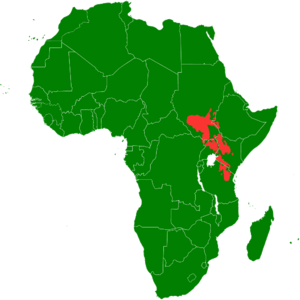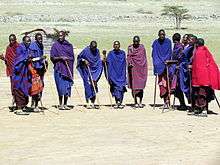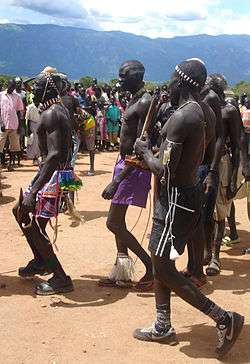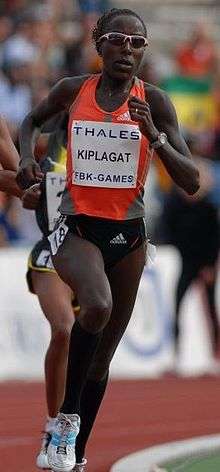Nilotic peoples
| Regions with significant populations | |
|---|---|
| Nile Valley, African Great Lakes, southwestern Ethiopia | |
| Languages | |
| Nilo-Saharan languages | |
| Religion | |
| Traditional faiths, Christianity |
Nilotic peoples are peoples indigenous to the Nile Valley that speak Nilotic languages, which comprise a large sub-group of the Nilo-Saharan languages spoken in South Sudan, Uganda, Kenya, and northern Tanzania.[1] In a more general sense, the Nilotic peoples include all descendants of the original Nilo-Saharan speakers. Among these are the Luo, Sara, Maasai, Kalenjin, Dinka, Nuer, Shilluk, Ateker, and the Maa-speaking peoples, each of which is a cluster of several ethnic groups.[2]
Nilotes form the majority of the population in South Sudan, an area that is believed to be their original point of dispersal. They also constitute the second-largest group of peoples inhabiting the African Great Lakes region (after the Bantu peoples),[2] with a notable presence in southwestern Ethiopia as well.
Nilotes primarily adhere to Christianity and traditional faiths, including the Dinka religion.
Name
The terms Nilotic and Nilote were previously used as racial sub-classifications, based on anthropological observations of the distinct body morphology of many Nilotic speakers. These perceptions were later widely discarded by 20th century social-scientists,[3] but today they again find support in population genetics.[4]
These terms are now mainly used to distinguish "Nilotic people" based on ethnic/linguistic affiliation. Etymologically, the terms Nilotic and Nilote (singular nilot) derive from the Nile Valley; specifically, the Upper Nile and its tributaries, where most Sudanese Nilo-Saharan-speaking people live.[5]
Origins and history

A Proto-Nilotic unity, separate from an earlier undifferentiated Eastern Sudanic unity, is assumed to have emerged by the 3rd millennium BC. The emergence of the Proto-Nilotes may have been connected with the domestication of livestock. The Eastern Sudanic unity must have been considerably earlier still, perhaps around the 5th millennium BC (while the proposed Nilo-Saharan unity would even date to the Upper Paleolithic about 15kya). The original locus of the early Nilotic speakers was presumably east of the Nile in what is now South Sudan. The Proto-Nilotes of the 3rd millennium BC were pastoralists, while their neighbors, the Proto-Central Sudanic peoples were mostly agriculturalists.[6]
By about the 12th century, Luo peoples occupied the area that now lies in eastern Bahr el Ghazal. A "Nilotic expansion" southward, accompanied by ethnic and linguistic diversification, took place from about the 14th century. The reason was presumably the Islamization of Sudan and the eventual collapse of the Nubian Christian kingdom of Alodia. Most of the Luo moved to nearly all the countries neighbouring Sudan, resulting in many separate groups with variation in language and tradition as each group moved further away from their kin. A branch of the Luo, the Shilluk (or Chollo) nation, comprising more than one hundred clans and sub-tribes, was founded by a chief named Nyikango sometime in the middle of the 15th century. They evolved a nation with a feudal-style system. Nyikango and his nation moved northward along the Nile, towards Kush. The rest of the Luo groups rejected Nyikango's idea and kept a south and westwards migration.
The further spread of the Nilotes to their modern territories was a process spanning about the 15th to 18th centuries. Thus, the Maasai, according to their own oral history, migrated south from the lower Nile valley north of Lake Turkana in about the 15th century, arriving in a long trunk of land stretching from what is now northern Kenya to what is now central Tanzania during the 17th and 18th centuries.
Ethnic/linguistic divisions
Languages

Linguistically, Nilotic people are divided into three sub-groups:
- Eastern Nilotic - Spoken by Nilotic populations in southwestern Ethiopia, eastern South Sudan, northeastern Uganda, western Kenya and northern Tanzania. Includes languages like Turkana and Maasai.
- Bari
- Teso–Lotuko–Maa
- Southern Nilotic - Spoken by Nilotic populations in western Kenya, northern Tanzania and eastern Uganda. Includes Kalenjin and Datog.
- Kalenjin
- Omotik–Datooga
- Western Nilotic - Spoken by Nilotic populations in South Sudan, Sudan, northeastern Congo (DRC), northern Uganda, southwestern Kenya, northern Tanzania and southwestern Ethiopia. Includes Dinka and Luo.
- Dinka–Nuer
- Luo
Ethnic groups

Nilotic people constitute the bulk of the population of South Sudan. The largest of the Sudanese Nilotic peoples is the Dinka, which includes as many as twenty-five ethnic subdivisions. The next largest group is the Nuer, followed by the Shilluk.[7]
The Nilotic people in Uganda include the Luo (Acholi, Alur and Adhola), Ateker (Teso and Karamojong), Lango and Kumam.
In East Africa, the Nilotes are often subdivided into three general groups:
- The Plain Nilotes: they speak Maa languages and include the Maasai, Samburu and Turkana[2]
- The River Lake Nilotes: the Joluo (Kenyan Luo), who are part of the larger Luo group[2]
- The Highland Nilotes: subdivided into two groups; the Kalenjin and the Datog
Culture and religion
Most Nilotes practice pastoralism.[2] Some tribes are also known for a tradition of cattle raiding.[9]
Nilotes in East Africa have through interaction adopted many customs and practices from neighboring Southern Cushitic groups. The latter include the age set system of social organization, circumcision, and vocabulary terms.[2][10]
In terms of religious beliefs, Nilotes primarily adhere to traditional faiths and Christianity. There is a pantheon of deities in the Dinka religion. The Supreme, Creator God is Nhialic, who is the God of the sky and rain, and the ruler of all the spirits.[11] He is believed to be present in all of creation, and to control the destiny of every human, plant and animal on Earth. Nhialic is also known as Jaak, Juong or Dyokin by other Nilotic groups, such as the Nuer and Shilluk. Dengdit or Deng, is the sky God of rain and fertility, empowered by Nhialic.[12] Deng's mother is Abuk, the patron Goddess of gardening and all women, represented by a snake.[13] Garang, another deity, is believed or assumed by some Dinka to be a God suppressed by Deng whose spirits can cause most Dinka women, and some men, to scream. The term "Jok" refers to a group of ancestral spirits.
In the Lotuko mythology, the chief God is called Ajok. He is generally seen as kind and benevolent, but can be angered. He once reportedly answered a woman's prayer for the resurrection of her son. Her husband, however, was angry and re-killed the child. According to the Lotuko religion, Ajok was annoyed by his actions and swore to never resurrect any Lotuko again, and in this manner, death was said to have become permanent.
Genetics
Y DNA

A Y-chromosome study by Wood et al. (2005) tested various populations in Africa for paternal lineages, including 26 Maasai and 9 Luo from Kenya and 9 Alur from the Democratic Republic of Congo. The signature Nilotic paternal marker Haplogroup A3b2 was observed in 27% of the Maasai, 22% of the Alur, and 11% of the Luo.[14] Haplogroup B, another characteristically Nilotic paternal marker according to Gomes et al. (2010),[15] was found in 22% of Wood et al.'s Luo samples and 8% of the studied Maasai. The E1b1b haplogroup was also observed in 50% of the Maasai,[14] which is indicative of substantial gene flow into this population from Cushitic males.[16] In addition, 67% of the Alur samples possessed the Sub-Saharan E2 haplogroup.[14]
Another study by Hassan et al. (2008) analysed the Y-DNA of populations in the Sudan region, with various local Nilotic groups included for comparison. The researchers found the signature Nilotic A and B clades to be the most common paternal lineages amongst the Nilo-Saharan speakers, except those inhabiting western Sudan, where an appreciable North African influence was noted. Haplogroup A was observed amongst 62% of Dinka, 53.3% of Shilluk, 46.4% of Nuba, 33.3% of Nuer, 31.3% of Fur and 18.8% of Masalit. Haplogroup B was found in 50% of Nuer, 26.7% of Shilluk, 23% of Dinka, 14.3% of Nuba, 3.1% of Fur and 3.1% of Masalit. The E1b1b clade was also observed in 71.9% of the Masalit, 59.4% of the Fur, 39.3% of the Nuba, 20% of the Shilluk, 16.7% of the Nuer, and 15% of the Dinka. Hassan et al. attributed the atypically high frequencies of the haplogroup in the Masalit to either a recent population bottleneck that likely altered the community's original haplogroup diversity or to geographical proximity to E1b1b's place of origin in North Africa, where the researchers suggest that the clade "might have been brought to Sudan from[...] after the progressive desertification of the Sahara around 6,000–8,000 years ago".[17] Henn et al. (2008) similarly observed Afro-Asiatic influence in the Nilotic Datog of northern Tanzania, 43% of whom carried the M293 sub-clade of E1b1b.[18]
mtDNA
Unlike their paternal DNA, the maternal lineages of Nilotes in general show low-to-negligible amounts of Afro-Asiatic and other extraneous influences. An mtDNA study by Castri et al. (2008) examined the maternal ancestry of various Nilotic populations in Kenya, with Turkana, Samburu, Maasai and Luo individuals sampled. Almost all of the tested Nilotes belonged to various Sub-Saharan macro-haplogroup L sub-clades, including L0, L2, L3, L4 and L5. Low levels of maternal gene flow from North Africa and the Horn of Africa were also observed in a few groups, mainly via the presence of mtDNA haplogroup M and haplogroup I lineages in about 12.5% of the Maasai and 7% of the Samburu samples, respectively.[19]
Autosomal DNA
The autosomal DNA of Nilotic peoples has been examined in a comprehensive study by Tishkoff et al. (2009) on the genetic affiliations of various populations in Africa. According to the researchers, Nilotes generally form their own Sub-Saharan genetic cluster. The authors also found that certain Nilotic populations in the eastern Great Lakes region, such as the Maasai, showed some additional Afro-Asiatic affinities due to repeated assimilation of Cushitic-speaking peoples over the past 5000 or so years.[20]
Physiology

Physically, Nilotes are noted for their typically very dark skin color and slender, tall bodies. They often possess exceptionally long limbs, particularly vis-a-vis the distal segments (forearms, calves). This characteristic is thought to be a climatic adaptation to allow their bodies to shed heat more efficiently.
Sudanese Nilotes are regarded as one of the tallest peoples in the world. Roberts and Bainbridge (1963) reported average values of 182.6 cm (71.9") for height and 58.8 kg (129.6 lbs) for weight in a sample of Sudanese Shilluk.[21] Another sample of Sudanese Dinka had a stature/weight ratio of 181.9 cm/58.0 kg (71.6"/127.9 lbs), with an extremely ectomorphic somatotype of 1.6-3.5-6.2.
In terms of facial features, Hiernaux (1975) observed that the nasal profile most common amongst Nilotic populations is broad, with characteristically high index values ranging from 86.9 to 92.0. He also reported that lower nasal indices are often found amongst Nilotes who inhabit the more southerly Great Lakes region, such as the Maasai, a fact which he attributed to genetic differences.[22]
Additionally, it has been remarked that the Nilotic groups presently inhabiting the African Great Lakes region are sometimes also smaller in stature than those residing in the Sudan region. Campbell et al. (2006) recorded measurements of 172.0 cm/53.6 kg (67.7"/118.2 lbs) in a sample of agricultural Turkana in northern Kenya, and of 174.9 cm/53.0 kg (68.8"/116.8 lbs) in pastoral Turkana.[23] Hiernaux similarly listed a height of 172.7 cm (68") for Maasai in southern Kenya, with an extreme trunk/leg length ratio of 47.7.[22]
Many Nilotic groups also excel in long and middle distance running. It has been argued that this sporting prowess stems from their exceptional running economy, which in turn is a function of slim body morphology and slender legs.[24] A study by Pitsiladis et al. (2006) questioning 404 elite Kenyan distance runners found that 76% of the international-class respondents hailed from the Kalenjin ethnic group and that 79% spoke a Nilotic language.[25]
References
- ↑ "Nilotic". The American Heritage Dictionary of the English Language (5th ed.). Houghton Mifflin Harcourt Publishing. 2015. Retrieved 5 August 2015.
- 1 2 3 4 5 6 7 Okoth, Assa; Ndaloh, Agumba (2006). Peak Revision K.C.P.E. Social Studies. Nairobi, Kenya: East African Educational Publishers. pp. 60–62. ISBN 978-9966-25-450-4. Retrieved 5 August 2015.
- ↑ The Forging of Races Cambridge University Press THE FORGING OF RACES - by Colin Kidd Excerpt
- ↑ Sarah A. Tishkoff et al.: The Genetic Structure and History of Africans and African Americans
- ↑ Encyclopædia Britannica Article: Nilot
- ↑ John Desmond Clark, From Hunters to Farmers: The Causes and Consequences of Food Production in Africa, University of California Press, 1984, p. 31
- ↑ Helen Chapin Metz, ed. Sudan: A Country Study. Washington: GPO for the Library of Congress, 1991.
- ↑ Oboler, Regina Smith (1985). Women, Power, and Economic Change: The Nandi of Kenya. Stanford University Press. p. 17. ISBN 0804712247.
- ↑ "South Sudan horror at deadly cattle vendetta". BBC News. January 12, 2012.
- ↑ Robert O. Collins, The southern Sudan in historical perspective, (Transaction Publishers: 2006), p.9-10.
- ↑ Lienhardt, p 29
- ↑ Lienhardt, p 104
- ↑ Lienhardt, p 90
- 1 2 3 Elizabeth T Wood, Daryn A Stover, Christopher Ehret et al., "Contrasting patterns of Y chromosome and mtDNA variation in Africa: evidence for sex-biased demographic processes", European Journal of Human Genetics (2005) 13, 867–876. (cf. Appendix A: Y Chromosome Haplotype Frequencies)
- ↑ Gomes, V; Sánchez-Diz, P; Amorim, A; Carracedo, A; Gusmão, L (Mar 2010). "Digging deeper into East African human Y chromosome lineages". Hum Genet. 127 (5): 603–13. doi:10.1007/s00439-010-0808-5. PMID 20213473.
- ↑ Cruciani; et al. (May 2004). "Phylogeographic Analysis of Haplogroup E3b (E-M215) Y Chromosomes Reveals Multiple Migratory Events Within and Out Of Africa". Am J Hum Genet. 74 (5): 1014–1022. doi:10.1086/386294. PMC 1181964
 . PMID 15042509.
. PMID 15042509. - ↑ Hassan, Hisham Y. et al. (2008), Y-Chromosome Variation Among Sudanese: Restricted Gene Flow, Concordance With Language, Geography, and History, American Journal of Physical Anthropology (2008), Volume: 137, Issue: 3, Pages: 316-323
- ↑ Henn; Gignoux; Lin, Alice A; Oefner, Peter J. (2008), "Y-chromosomal evidence of a pastoralist migration through Tanzania to southern Africa", PNAS, 105 (31): 10693–10698, doi:10.1073/pnas.0801184105, PMC 2504844
 , PMID 18678889
, PMID 18678889 - ↑ Castrí (2008). "Kenyan crossroads: migration and gene flow in six ethnic groups from Eastern Africa." (PDF). J Anthropol Sci. 86: 189–92. PMID 19934476.
- ↑ Tishkoff; et al. (2009), "The Genetic Structure and History of Africans and African Americans", Science, 324: 17, doi:10.1126/science.1172257, PMC 2947357
 , PMID 19407144; Also see Supplementary Data
, PMID 19407144; Also see Supplementary Data - ↑ D. F. Roberts, D. R. Bainbridge: Nilotic physique" American Journal of Physical Anthropology 1963, p. 341-370
- 1 2 Jean Hiernaux, The People of Africa, (Scribners: 1975), pp.142-143 & 147.
- ↑ B. Campbell, P. Leslie, K. Campbell: Age-related Changes in Testosterone and SHBG among Turkana Males. American Journal of Human Biology 2006, p. 71-82
- ↑ Bengt Saltin: The Kenya project - Final report. New Studies In Athletics, vol. 2, pp. 15-24
- ↑ Yannis Pitsiladis, Vincent O. Onywera, Robert A. Scott, Michael K. Boit. "Demographic characteristics of elite Kenyan endurance runners" (PDF). Retrieved 20 June 2012.
Bibliography
- (English) Lienhardt, Godfrey, "Divinity and Experience: The Religion of the Dinka", Oxford University Press (1988), ISBN 0198234058 (Retrieved : 9 June 2012)

